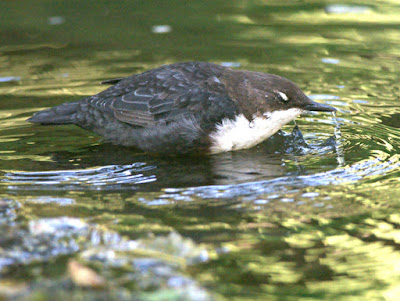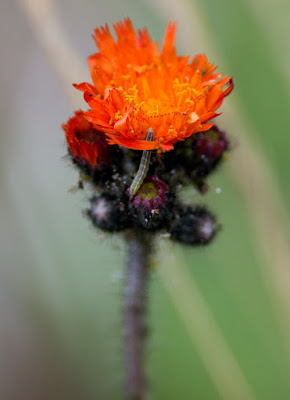On the way towards the main hide, I noticed this Honey-bee sitting on a leaf and furiously trying to clean white pollen off its head and thorax.
The source of this white pollen was Himalayan Balsam, a beautiful but invasive non-native plant which unfortunately has more than a foothold here. Clearing it while it's flowering can be counterproductive, as mature seed pods burst when lightly touched, hurling a new generation of seed in all directions.
Another pretty pink flower, but this one's a native. Rosebay Willowherb, pretty much looking its best at the moment.
And, enjoying a bit of willowherb nectar, an unidentified moth.
Another insect. This one I thought was the longhorn flower beetle Rutpela maculata, which I've seen before, but on investigation later I found that it was the fractionally rarer Leptura quadrifasciata.
And so to the hide. We looked through the screen at the bottom first, and there was the Great White Egret that's been here a while. However, in between us seeing it down here and then climbing the stairs up to the hide proper, it flew off, and we didn't see it again.
A small crowd of birds on the shoreline nearest us - three Black-tailed Godwits, a Teal and a juvenile Black-headed Gull.
Another juvvy Black-headed, this one screaming at an uninterested adult which may or may not be its mum or dad. Also on view from here (but distantly) were a Greenshank and a Green Sandpiper, plenty of Lapwings, and a scattering of Teals, Gadwalls, Shovelers and Mallards.
A Blackwit moving from A to B. What a gloomy day.
A few late Swifts drifted through.
We left the hide and wandered through the meadowy areas, now full of neck-high plants, including some sunflowers and some wheat, which are presumably planted here to provide winter food for songbirds. Pity it wasn't a prettier insect that posed on this wheat head.
HERE is a prettier insect, though she is starting to fray and fade at the edges - Meadow Brown.
One or two dragons appeared in the few sunny intervals. Here's the best I could do with this high-flying Migrant Hawker.
The walk back wasn't too eventful. We found a couple of Blue-tailed Damselflies.
And last of all, a Buzzard trying to gain height in skies that had gone back to cloudy grey.






























































